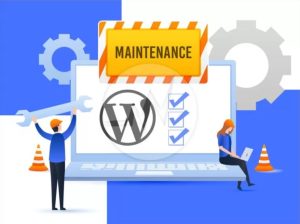WordPress Preventative Maintenance: A Comprehensive Guide
 Introduction
Introduction
WordPress is the world’s most popular content management system (CMS), powering millions of websites globally. Its flexibility, ease of use, and extensive plugin ecosystem make it a top choice for everyone from bloggers to large enterprises. However, to ensure your WordPress site remains secure, fast, and functional, regular preventative maintenance is crucial. This article provides a comprehensive guide to WordPress preventative maintenance, covering essential tasks and best practices.
1. Regular Backups
One of the most critical aspects of maintaining a WordPress site is performing regular backups. Backups ensure that you can quickly restore your site in case of data loss, hacking, or other issues. Here are some tips for effective backups:
- Frequency: Perform backups at least once a week, or more frequently if you update your site often.
- Storage: Store backups in multiple locations, such as cloud storage (Google Drive, Dropbox) and local storage (external hard drive).
- Plugins: Use reliable backup plugins like UpdraftPlus, BackupBuddy, or Duplicator for automated backups.
2. Update WordPress Core, Themes, and Plugins
Keeping your WordPress core, themes, and plugins up to date is vital for security and functionality. Outdated software can be vulnerable to attacks and may cause compatibility issues. Follow these steps:
- WordPress Core: Regularly check for updates in your WordPress dashboard and apply them promptly.
- Themes and Plugins: Update themes and plugins regularly. Always read the changelog and test updates in a staging environment before applying them to your live site.
- Automatic Updates: Consider enabling automatic updates for minor core updates and plugins.
3. Security Scans and Monitoring
Protecting your WordPress site from security threats is a top priority. Regular security scans and monitoring can help identify and mitigate potential vulnerabilities. Here are some recommendations:
- Security Plugins: Install reputable security plugins like Wordfence, Sucuri, or iThemes Security to perform regular scans and monitor your site.
- Firewall: Implement a web application firewall (WAF) to block malicious traffic.
- SSL Certificate: Ensure your site has an SSL certificate to encrypt data and improve security.
4. Database Optimization
Over time, your WordPress database can become cluttered with unnecessary data, slowing down your site. Regular database optimization can improve performance and reduce the risk of errors. Here’s how:
- Optimization Plugins: Use plugins like WP-Optimize or WP-Sweep to clean up and optimize your database.
- Manual Optimization: Periodically review and remove unused themes, plugins, and old revisions of posts.
5. Check for Broken Links
Broken links can harm your site’s user experience and SEO. Regularly checking for and fixing broken links is essential for maintaining a healthy site. Here’s what to do:
- Broken Link Checker: Use plugins like Broken Link Checker to scan your site for broken links.
- Manual Checks: Periodically review your site’s content and manually check for broken links.
6. Monitor Site Performance
A fast-loading site is crucial for user satisfaction and SEO. Regularly monitoring and optimizing your site’s performance can help ensure it remains speedy. Consider these steps:
- Performance Plugins: Use plugins like WP Rocket, W3 Total Cache, or Autoptimize to improve site performance.
- Hosting: Choose a reputable hosting provider with good performance and support.
- Performance Testing: Regularly test your site’s performance using tools like Google PageSpeed Insights, GTmetrix, or Pingdom.
7. Content Updates and Audits
Keeping your content fresh and relevant is essential for engaging your audience and improving SEO. Regular content updates and audits can help achieve this:
- Content Refresh: Update old posts with new information, images, and links.
- Content Audit: Periodically review your site’s content to identify outdated or low-performing posts that need improvement.
8. User Management
Managing user accounts effectively is essential for maintaining security and organization on your WordPress site. Follow these best practices:
- Role Management: Assign appropriate user roles and permissions to prevent unauthorized access.
- Inactive Users: Regularly review and remove inactive user accounts.
- Strong Passwords: Enforce the use of strong passwords for all user accounts.
9. Regular Monitoring and Reporting
Continuous monitoring and reporting help you stay informed about your site’s health and performance. Consider these practices:
- Google Analytics: Install Google Analytics to track visitor behavior and site performance.
- Uptime Monitoring: Use services like UptimeRobot or Pingdom to monitor your site’s uptime and receive alerts if it goes down.
- Reports: Generate regular reports on site performance, security, and user activity.
Conclusion
Preventative maintenance is essential for ensuring the longevity, security, and performance of your WordPress site. By following the tips and best practices outlined in this guide, you can keep your site running smoothly and provide a positive experience for your visitors. Regular backups, updates, security scans, and performance optimization are just a few of the key tasks that should be part of your maintenance routine. Stay proactive, and your WordPress site will continue to thrive.
